Hue, the former imperial capital of Vietnam, boasts a wealth of architectural and cultural treasures that captivate visitors from around the world. At the heart of this historic city lie the majestic royal tombs and the iconic Thien Mu Pagoda, each offering a unique glimpse into Vietnam’s regal past. Exploring these sites with the convenience of private car transportation allows travelers to enjoy the grandeur and intricate details of Hue’s architectural wonders, while enjoying personalized attention and the flexibility to tailor their sightseeing experience. As one delves deeper into this enchanting destination, the layers of history and artistry unfold, revealing why Hue remains a must-visit destination for those seeking to uncover Vietnam’s rich cultural legacy.
Key Points
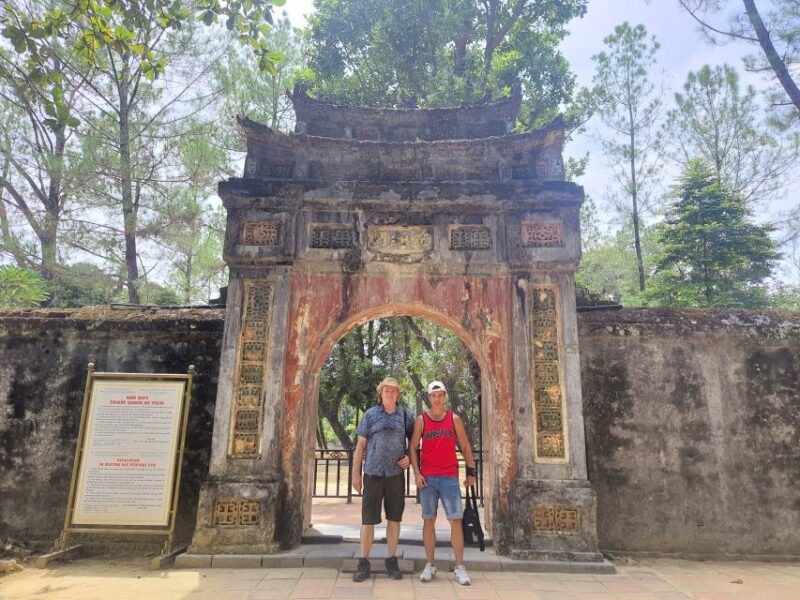
- Explore the majestic Imperial Citadel, a UNESCO World Heritage Site, and discover the blend of Vietnamese and European architectural styles.
- Visit the iconic Thien Mu Pagoda, an enduring symbol of Hue’s cultural heritage, and marvel at its 60-meter tall seven-tiered octagonal tower.
- Discover the Khai Dinh Tomb, a remarkable fusion of Vietnamese and European styles, showcasing the emperor’s passion for cultural integration.
- Experience the Minh Mang Tomb, considered one of the most beautiful royal tombs in Vietnam, with its harmonious blend of Vietnamese and Chinese architectural elements.
- Enjoy the comfort and convenience of private car transportation, with a customized itinerary and the opportunity for spontaneous stops to enhance your sightseeing experience.
Exploring Hue’s Imperial Citadel

Nestled along the Perfume River, Hue’s Imperial Citadel stands as a testament to Vietnam’s storied past, serving as the former capital and the last imperial city of the Nguyen dynasty.
Sprawling across 520 hectares, this UNESCO World Heritage Site showcases a remarkable blend of Vietnamese and European architectural styles, with grand palaces, ornate gates, and the revered royal tombs that dot the landscape.
Visitors can explore the intricate network of courtyards, pavilions, and gardens that once housed the Nguyen emperors, marveling at the attention to detail and the cultural significance of this historic complex.
The Imperial Citadel offers a glimpse into Vietnam’s imperial heritage, a must-visit destination for anyone seeking to understand the country’s rich history.
Want to keep it personal? More private experiences we love in Hue Vietnam
Discovering Thien Mu Pagoda
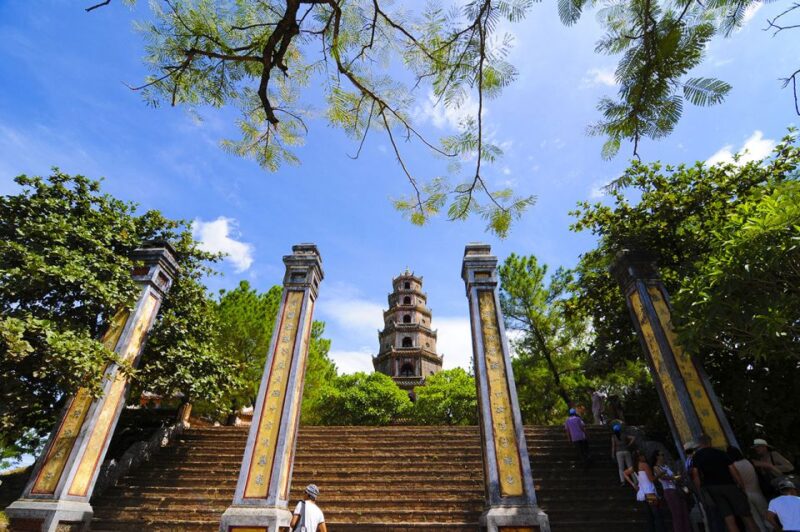
Beyond the imposing walls of the Imperial Citadel, visitors can’t help but be captivated by the towering presence of the Thien Mu Pagoda, one of Hue’s most iconic landmarks.
This ancient Buddhist temple, perched atop a hill along the gentle curves of the Perfume River, has borne witness to the city’s tumultuous history for over three centuries.
The pagoda’s striking seven-tiered octagonal tower, standing 60 meters tall, is a testament to the architectural prowess of the Nguyen dynasty.
Inside the temple complex, visitors can explore a collection of ancient artifacts, including a classic Vietnamese car that was once used by a Buddhist monk to protest against the government.
The Thien Mu Pagoda stands as a enduring symbol of Hue’s rich cultural heritage.
Visiting Khai Dinh Tomb
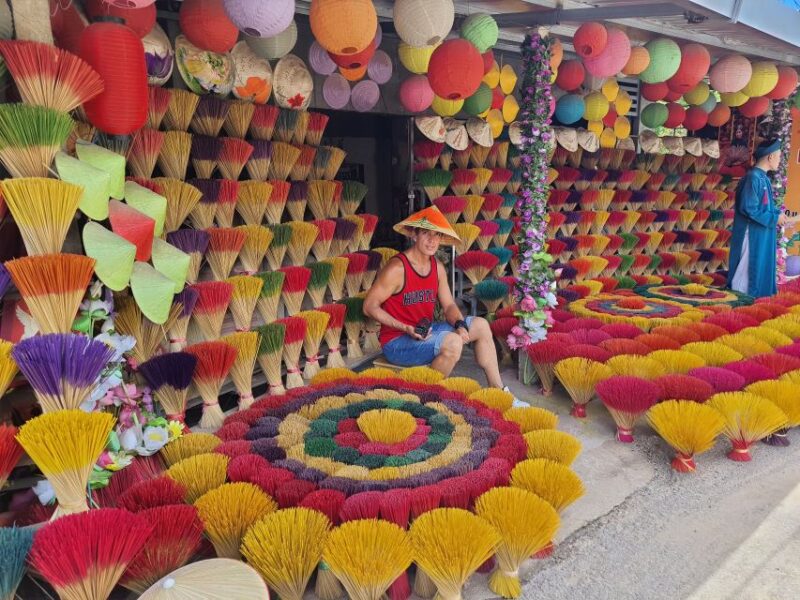
Visitors to Hue can discover the remarkable Khai Dinh Tomb, a magnificent blend of Vietnamese and European architectural styles that was built for the 12th emperor of the Nguyen dynasty. Perched atop Chau Chu mountain, this tomb showcases the emperor’s eclectic tastes, with its ornate tile work, intricate carvings, and a unique fusion of Eastern and Western design elements.
The tomb is a testament to the emperor’s passion for blending cultural influences, as evidenced by:
- The combination of traditional Vietnamese elements like pagoda-style roofs and imperial dragons with European touches like Renaissance-inspired columns and statues.
- The use of high-quality materials like marble, bronze, and rare stones to create a visually stunning and durable structure.
- The intricate details and craftsmanship that went into every aspect of the tomb’s design and construction.
Admiring Minh Mang Tomb
Minh Mang Tomb stands as a stunning mausoleum, often considered one of the most beautiful royal tombs in Vietnam. Situated amid a serene landscape, this magnificent structure was built to honor the second emperor of the Nguyen dynasty, who was known for his artistry and appreciation of traditional Vietnamese aesthetics. Visitors can marvel at the tomb’s intricate design, which features a harmonious blend of Vietnamese and Chinese architectural elements. The attention to detail is truly impressive, from the ornate carvings to the meticulously landscaped gardens. Exploring the Minh Mang Tomb offers a glimpse into the rich cultural heritage of Vietnam and the enduring legacy of its imperial past.
| Feature | Description |
|---|---|
| Architecture | Harmonious blend of Vietnamese and Chinese styles |
| Gardens | Meticulously landscaped and maintained |
| Carvings | Intricate and ornate, showcasing artistry |
| Atmosphere | Serene and peaceful, immersed in nature |
| Significance | Honors the 2nd Nguyen emperor, known for his aesthetics |
Uncovering the Tiger Arena
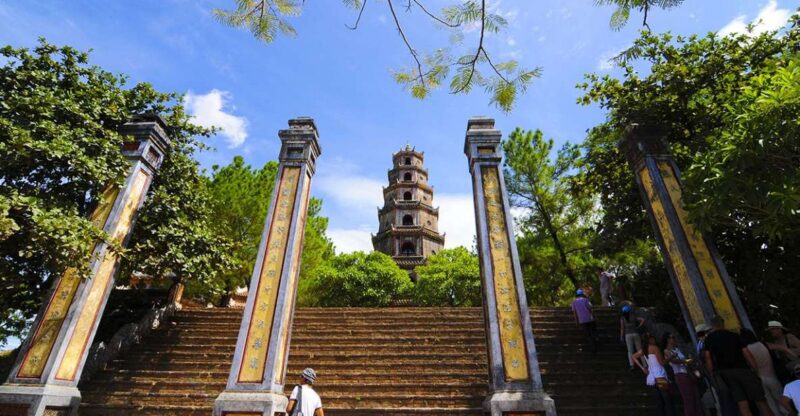
Nestled within the imperial legacy of Hue stands the captivating relic known as the Tiger Arena, a testament to Vietnam’s storied past. Built in 1830, this open-air arena once hosted the grand spectacle of royal tiger fights, where the power and ferocity of these majestic creatures were pitted against each other for the entertainment of the Nguyen emperors.
Though the last recorded game took place in 1904 during the reign of Emperor Thanh Thai, the Tiger Arena remains a fascinating historical site, its high-quality brick and stone walls still proudly preserving the grandeur of this unique sporting tradition.
The arena’s significance is further underscored by its:
- Donut-shaped design, allowing for optimal viewing
- Role as a testament to the imperial power and cultural traditions of the Nguyen dynasty
- Status as a rare surviving example of this type of specialized arena in Vietnam
Here are more great tours and experiences we've reviewed in Hue Vietnam
- Chan May Port to Hue Imperial City Tour by Private Car
- From Hue to Hoi an With Sightseeing by Private Car ( 1 Way)
- Hue & Hoi An Transfer: Private Car Sightseeing Trip
- From Hue: 5-Hour Sightseeing Drive to Hoi An by Private Car
- Tien Sa Port to Hue Imperial City & Sightseeing Private Car
- Hue Royal Tombs and Thien Mu Pagoda With Private Car
Discovering Abandoned Thuy Tien Lake
Thuy Tien Lake’s abandoned water park lies nestled on Thien An hill, approximately 10 kilometers southwest of Hue’s city center, beckoning adventure-seekers with its eerie allure.
Situated atop the picturesque hill, the once-vibrant attraction has since fallen into disrepair, its crumbling structures and overgrown foliage serving as a haunting reminder of its former glory.
Visitors can explore the decaying remains of the park’s various rides and facilities, including the giant concrete dragon that once guarded the entrance.
Despite its dilapidated state, Thuy Tien Lake continues to captivate those drawn to the mystique of abandoned places, offering a unique glimpse into the past and a chance to experience the bittersweet beauty of nature reclaiming what was once man-made.
Private Car Transportation
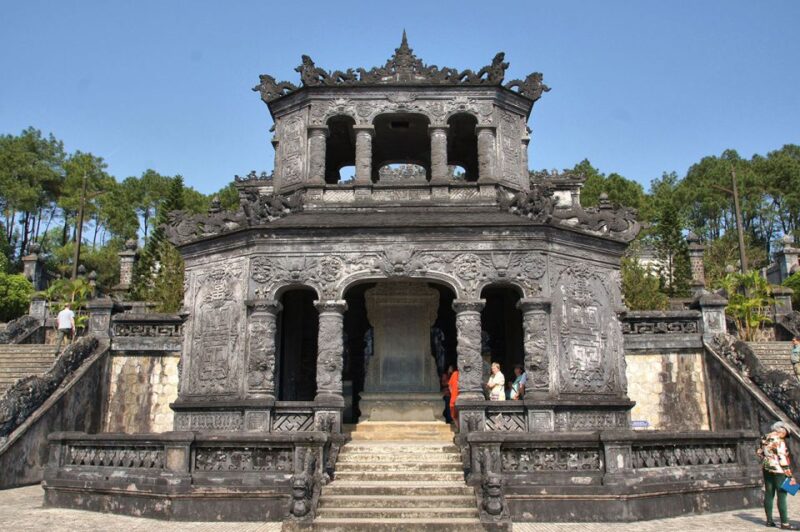
Traversing the historic sites of Hue’s Imperial Citadel and Thien Mu Pagoda is made effortless with the convenience of private car transportation, allowing visitors to explore these renowned landmarks at their own pace.
Private car services offer a range of benefits that enhance the overall experience:
- Personalized attention and flexibility: Visitors can customize their itinerary, make spontaneous stops, and enjoy a more personalized tour at their own pace.
- Comfort and convenience: Spacious, air-conditioned vehicles provide a comfortable and hassle-free mode of transportation, ensuring a relaxing journey.
- Knowledgeable drivers: Experienced local drivers offer valuable insights and recommendations, enriching the sightseeing experience with their deep understanding of the region’s history and culture.
Hue’s Architectural Wonders
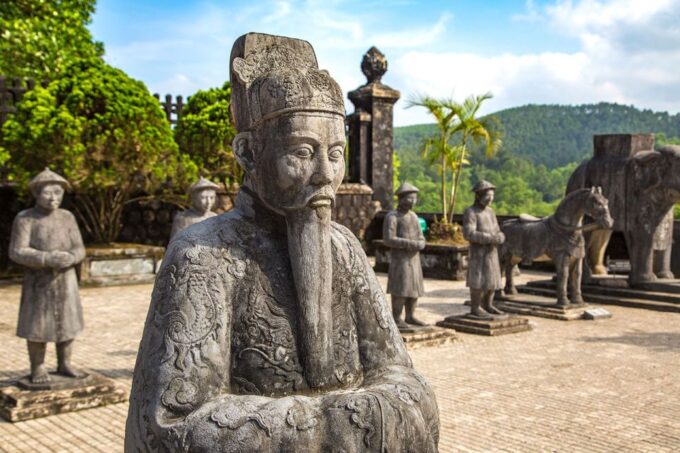
Hue’s Imperial Citadel and Thien Mu Pagoda showcase the city’s rich architectural heritage, blending Vietnamese traditions with European influences to create awe-inspiring structures that captivate visitors. The Imperial Citadel, the former capital of Vietnam, boasts grand palaces, ornate gates, and serene royal tombs. Among these, the Khai Dinh Tomb and the Minh Mang Tomb stand out, showcasing a magnificent fusion of Vietnamese and European design elements. Meanwhile, the iconic Thien Mu Pagoda, one of Hue’s most recognizable landmarks, embodies the city’s deep-rooted Buddhist history. These architectural gems offer visitors a glimpse into Vietnam’s imperial past and the country’s cultural evolution.
| Imperial Citadel | Thien Mu Pagoda |
|---|---|
| Former capital of Vietnam | One of Hue’s most iconic landmarks |
| Palaces, gates, and royal tombs | Embodiment of Vietnam’s Buddhist heritage |
| Khai Dinh Tomb: Blend of Vietnamese and European architecture | – |
| Minh Mang Tomb: One of the most beautiful royal tombs | – |
Frequently Asked Questions
Is Photography Allowed at All Locations?
Photography is generally permitted at the Imperial Citadel, Thien Mu Pagoda, and the royal tombs, although some restrictions may apply in certain areas. The abandoned Thuy Tien Lake site also allows photography, making it a popular spot for adventure seekers.
What Should I Bring for a Day of Sightseeing?
For a day of sightseeing, visitors should bring comfortable walking shoes, sun protection, water, snacks, and cash for any entrance fees or purchases. Bringing a camera to capture the stunning architecture and natural scenery is also recommended.
Are There Any Dress Code Requirements?
When visiting historical sites in Vietnam, visitors should dress modestly and avoid revealing clothing. Shorts, short skirts, and sleeveless tops are generally discouraged out of respect for the cultural and religious significance of these locations.
Can I Explore the Sites on My Own or Do I Need a Guide?
Visitors can explore the sites on their own, but a guide can provide valuable insights and historical context. Guides can also help navigate the sites and ensure visitors see the highlights. Independent exploration is possible, but a guide is recommended for a more enriching experience.
Are There Any Restaurants or Food Options at the Sites?
There are some food options at the Hue royal sites. Visitors can find small eateries and cafes within the Imperial Citadel and near the royal tombs that offer Vietnamese cuisine and refreshments. Dining options range from quick snacks to full meals.
Recap
Hue’s architectural wonders showcase the city’s rich cultural heritage. The Imperial Citadel, Thien Mu Pagoda, and Nguyen emperors’ tombs offer a glimpse into Vietnam’s enduring legacy.
Exploring these sites with private car transportation allows for personalized attention and flexibility, ensuring a memorable experience.
From the iconic tower to the ornate tombs, Hue’s architectural marvels captivate visitors, preserving the essence of the former imperial capital.
You can check if your dates are available here:More Private Car with Driver in Hue Vietnam
- Hue Food Tour by Walking or Cyclo or Motorcycle With Driver!
- Hue: Private Car To/From Hoi an via Multi Attractions(1-Way)
- Private Car: Hue City Day Trip With Driver
- Hue Heritage: Private Car Tour, No Guide
- Hue: DMZ Half-Day by Private Car With Vinh Moc Tunnels
- Hue to Hoi An: Private Car With English Driver & Sightseeing
More Private Tours in Hue Vietnam
- Hue City Tour Half Day by Private Car & Dragon Boat Option
- Hue: Private Dragon Boat, Thien Mu Pagoda, & Royal Tomb Tour
- Hue: Royal Tombs & Pagoda Tour By Dragon Boat & Private Car
- Hue: Private City Tour by Car With English-Speaking Driver
- Hue: Private City Tour By Car – English Speaking Driver
- Top 5 Hue Attractions: Private Car With English Driver
More Tour Reviews in Hue Vietnam
- Da Nang: Hue Day Trip From Danang by Car & Tour Guide
- Hue: Full-day Bach Ma National Park Trek And Beach Retreat
- From Hue: Botanic Garden, Paradise Cave, and Dark Cave Tour
- Chan May Port: Hue Heritage Tour
- Hue Imperial Private Tour via Hai Van Pass Train Experience
- Hue Private Sightseeing Highlights Tour Plus Edited Video
Not for you? Here's more things to do in Hue Vietnam we have recnetly reviewed
- NYNA Travel: 5 DAYS 4 NIGHTS Da Nang – Hue – Hoi An
- Hue Private City Highlights Tour With Female Tour Guide
- Tour Huế on the Back of a Motorbike
- Hue: Truoi Lake Serenity & Scenic Journey Over Hai Van Pass
- Hue City Sightseeing Private Tour By Train From Da Nang
- Hue To Hoi An Via Hai Van Pass & BaNa Hills -Golden Bridge
- CENTRAL VIETNAM TOUR 4 DAYS 3 NIGHTS
- NYNA Travel: 6 DAYS 5 NIGHTS Da Nang – Hue – Hoi An
- From Quang Binh: DMZ Quang Tri and Hue Guide Tour
- Hue To/From HoiAn: Sightseeing Transfer Between Hue & Hoi An
- Hue To Hoi An Via Hai Van Pass & BaNa Hills – Golden Bridge
- Hue By Night A Romantic Dragon Boat Cruise
